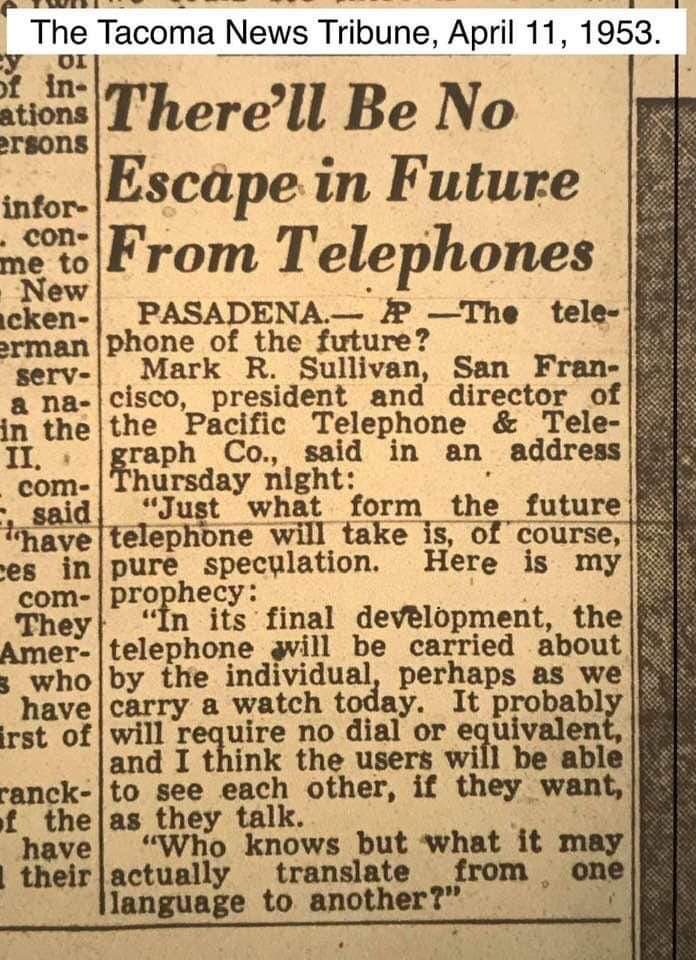Can you imagine the future of public relations be in 2041? Buckle your seatbelt and get ready for what’s next.
By Stephen Dupont, APR, Fellow PRSA
In April 1953, the Pasadena, Calif. office of the Associated Press issued a story about the future of telephones. At the time, all phones were “landlines” and utilized rotary dials.
The article was headlined, “There’ll be no Escape in the Future from Telephones,” and ran in newspapers across the country. It quoted Mark R. Sullivan, president of San Francisco-based Pacific Telephone and Telegraph Company, who said: “In its final development, the telephone will be carried about by the individual, perhaps as we carry a watch today. It probably will require no dial or equivalent, and I think the users will be able to see each other, if they want, as they talk.”

By the way, the FaceTime video feature for iPhones was introduced by Apple in June 2010.
Fast-forward to 2041
Now, imagine if you will, it’s the year 2041. What do you think the future of public relations will be like in the United States and Canada?
As someone who has practiced public relations for more than 25 years, and who also studies foresight, I’ve wondered about this many times. As I speak to PRSA members across the country, in person and online, as well as to classrooms of college students studying strategic communications, I look at some of the younger members of our profession and wonder: What will their professional lives look like 20 or even 30 years from now? Whatever might occur in our profession, budding strategic communications professionals need consider adopting a futures mindset, like Mark R. Sullivan did 53 years ago.
Thinking about the Future
There is one clear rule that professional futurists acknowledge when they develop scenarios for their clients: There is no one future.
As we look ahead 20 or 30 years, there are any number of possible futures. Some are more probable than others, and they range from horrible futures to incredibly bright futures. The reality is likely to be somewhere in between. As we live through these present times, which brim with complexity, it’s important to understand that what is a bright future to one person may be a dismal future to someone in another part of the world, or to persons of a different race, sexual identity, religion or creed. The lesson we can learn from history is it is multi-layered, like an onion, and that possible futures are equally complex.
Drivers of Change
Change happens continuously.
It can happen gradually, like a slowly dripping faucet – drip…drip…drip – one change building upon another. Did you know, for example, according to ComputerWorld, that in 1946, AT&T offered the first commercial mobile telephone service to subscribers in St. Louis? And yet, because it was so expensive, it had few takers.
Change also can happen very suddenly. I remember sitting in the lunchroom with my colleagues at Carmichael Lynch Spong Public Relations on the morning of 9/11 watching the TV in utter disbelief. Everyone in the room knew that event would change everything. Today, 20 years later, we are still experiencing the ripple effects of that historic event. impactful change.
When it comes to the public relations field, I believe a handful of factors will drive change within our profession over the next two decades. These include:
More Attention Now – We already live in an attention economy where brands seek our attention and attempt to keep it for as long as possible. This will become increasingly more difficult as the amount of commercial messages (written, audio, video, virtual) will continue to increase and bombard our senses. Today, many marketers measure success by impressions; tomorrow, with implantable chips, we will measure (because we will actually be able to do so) how long – in seconds – a brand was able to keep a person’s attention.
Traditional Media – Print media (newspapers, magazines, books), as well as broadcast media (TV, radio, cable) are undergoing huge changes as the news media continues to digitize online. Meanwhile, the delivery of news is being replaced by social media. In 2041, everything will be digital. Most news will be delivered by video or through a virtual reality experience. What impacts or challenges might that create for a free press, a cornerstone of our democracy?
Artificial Intelligence (AI), Data Mining, Automation – The use of AI, data mining, automation is already making advances into the world of public relations and will drive further change in the years to come. AI-driven software will write news stories, distribute the news, and select the news you view or hear. AI, combined with data mining, will ensure that more people within your target market are actually exposed to your news. And, by the way, your new work colleague may well be an android.

Mobile Communications – As I mentioned, change can happen rapidly. When the Covid-19 pandemic hit and most public relations professionals were forced to work remotely, we immediately turned to online video technology, such as Zoom, and online productivity tools, such as Slack, which allowed us to work and communicate from anywhere. According to a Frost and Sullivan report, more than 88% of C-Suite leaders say video makes meetings more effective, and more than 80% say it reduces meeting times, accelerates decision-making, and improves productivity. We may hunger for in-person events and meetings, but the fact is, video will just become more ubiquitous in everything we do to communicate in the future.
Threats of Autocracy – The foundation of the public relations industry is the First Amendment of the U.S. Constitution, which guarantees our right to free speech. However, across the world, including in major democracies, autocrats are consolidating power and abridging free speech rights. When we lose free speech, public relations becomes nothing more than propaganda. The second rule of professional futurists: don’t assume everything stays the same, and this includes our democracy.
Trust – Trust is the oil the greases the flow of ideas, goods and money. When people or groups stop trusting each other, paralysis sets in. This is what happened in the financial crash of 2008, when banks stopped trusting one another. Unfortunately, trust in our own government, according to the Pew Research Center, is at an all-time low.
Dealing with the Consequences of Global Warming – Every future for every person on this planet will be affected by climate change. All organizations, public and private, will become consumed by it. The era of announcing climate change goals, communicating actions to thwart global warming, and reporting on sustainability are here and will continue through the next several decades.

And Still More Change – The mainstream acceptance of electric vehicles, the end of the combustion engine, factory grown meat, the closure of the last coal plant, a Moon-base colony, the first landing of humans on Mars, the rise of China as a direct competitor to the U.S., the migration of millions due to rising sea levels – these are just a few of the numerous other changes that will affect us over the next 20 years. According to a 2019 Pew Research study, only a narrow majority of U.S. adults (56%) say they are somewhat or very optimistic about what the country will be like in 2050. On the flipside, both Pew Research and an annual study by Chapman University report that many Americans are pessimistic, stressful and actually fearful of specific types of change coming in the years ahead. This is the world into which we are heading.
Possible Futures
What do these trends mean for the future of public relations? I believe the two primary drivers of change for public relations will be technology, which already have had an immense impact on media, and trust – our trust in the governments, institutions, groups and individuals who share information.
It’s at this intersection where we could see a range of futures, from an authoritarian future where technology is used to sow distrust with misinformation and fake news – where no one or organization is trusted – to a future where humans work with technology, such as AI, to restore, rebuild and reimagine trust and transparency.
What To Do Now to Prepare for 2041
Here’s one thing that won’t change: storytelling. In fact, I believe in an all-electric, all-digital world, it will be more important than ever.
At the very heart of the public relations profession lies two truths: we are storytellers and we are the keepers of trust for the organizations, groups or persons we represent. Organizations will continue to rely upon professionally trained communicators to tell their stories.
To continue to fulfill that responsibility, in the years to come, focus on these critical skills:
Think Human-to-Human – AI and androids can’t replace humans. They’ll do a lot of things we can do more efficiently, but it’s impossible to replicate human empathy or human purpose. Stop thinking about B2B or B2C and start thinking about communicating human to human.
Writing – You can push a button to launch a million-dollar digital campaign but it’s useless without compelling headlines. The same with social media or any type of communication. For whatever medium, the written word is a reflection of thinking. Focus every day on making your writing more relevant, more concise, and more persuasive.
Creativity – Public relations professionals who differentiate themselves with their creativity, paired with their knowledge of how to leverage technology, will win the day in 2041.
Think Multimedia – While writing will continue to be the focus of communications, telling those stories will change with technology. Virtual reality, for example, is still in its infancy. Keep up with new communications technology.
Soft Skills – Continue to refine your soft skills – presenting, networking, sharing, leadership, critical thinking, analysis, scenario planning. Connecting with humans and being able to think critically will still be important skills.
Media Relations – The news media comprise the fourth pillar of modern democracies. In 2041, if we have maintained our democratic principles, there will still be news outlets in which to communicate important stories. Today’s upstart media will likely be tomorrow’s traditional media. There will be new social media platforms. There will be new influencers who reflect new generations yet to come (for example, Alpha Gen and Beta Gen). But the skill of persuading a reporter or an influencer to share a story will still be critical in 2041.
Communicating Vision – Most important of all, public relations professionals need to work on communicating visions of the future for their organizations and learning how to communicate change in a world that will change dramatically over the next 20 years. Because the fact is, people don’t like change – confident leaders who communicate well can help them overcome their fears.
Stephen Dupont, APR, Fellow PRSA, is VP of Public Relations and Branded Content for Pocket Hercules (www.pockethercules.com), a brand creative firm based in Minneapolis, Minnesota. He blogs at www.stephendupont.co. Dupont also is a member of the Association of Professional Futurists. Contact him at [email protected].